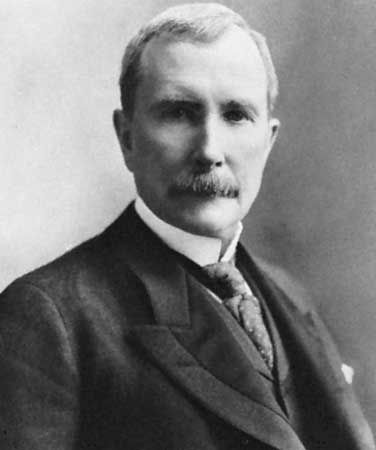Scaling Up (Rockefeller Habits): A Discipline Driven System for High Growth Companies
Business Operating System (BOS) - Part 4
Continued from Business Operating System (Part 3)
Most businesses don’t struggle because of a lack of opportunity. They struggle because of a lack of organizational discipline.
Where Scaling Up Comes From
Scaling Up is built on leadership disciplines first used by John D. Rockefeller while scaling Standard Oil into the most successful company of its era. Rockefeller’s approach weekly review rhythms, clear priorities, data-driven decisions, and strong management accountability was documented by historians and later recognized as the “Rockefeller Habits.”
Decades later, Verne Harnish, founder of Entrepreneurs’ Organization (EO), studied thousands of high-growth companies and noticed the same patterns. He modernized Rockefeller’s principles into a practical system for today’s SMBs and mid-market organizations.
In 2002 he published Mastering the Rockefeller Habits, and in 2014 expanded it into Scaling Up, which organizes business growth around four pillars: People, Strategy, Execution, and Cash. The result is a structured operating system that helps companies grow quickly without losing alignment or control.

This is a system built for organizations that feel the pressure of scale: more customers, more employees, more decisions, more fires. The promise of Scaling Up is straightforward: grow without breaking your company.
What Scaling Up Actually Is
Scaling Up is a business operating system designed around four essentials:
- People – getting the right people in the right seats
- Strategy – a clear, differentiated, long-term plan
- Execution – the habits and rhythms that make daily operations predictable
- Cash – making sure the company never runs out of oxygen while scaling
Unlike more visionary-focused systems (e.g., EOS), Scaling Up is extremely tactical. It’s built for companies ready to move fast but unwilling to lose control.

The Foundation: The 10 Rockefeller Habits
- The executive team is healthy and aligned.
They debate well, commit to decisions, and communicate clearly throughout the company. - Everyone is aligned with the #1 thing that must be accomplished this quarter.
A single, company-wide priority that matters more than everything else. - Communication rhythm is established, and information moves quickly.
Daily huddles, weekly meetings, monthly reviews, quarterly/annual planning. - Every facet of the organization has a person assigned with accountability.
Clear ownership for departments, processes, and outcomes. - Employees can articulate the company’s strategy in one sentence.
Simple, clear, and understood by everyone — not just leadership. - Leadership gathers customer feedback weekly.
Direct connection to customer needs, issues, opportunities. - Core values and purpose are known and lived throughout the organization.
Not posters — real cultural drivers guiding behavior and decisions. - A functional, documented org chart is in place.
Clear reporting structure and accountability pathways. - All employees have one or two KPIs they are responsible for.
Everyone knows their number and whether they’re winning. - Plans and performance are visible and measurable (dashboards).
Real-time data — financial, operational, and strategic — is accessible and reviewed regularly.
How the System Works
Scaling Up anchors the business around three core tools:
1. The One-Page Strategic Plan (OPSP)
This replaces long, unused strategy decks. Everything that matters vision, priorities, KPIs, accountability lives on one page.
2. The Meeting Rhythm
Harnish argues that scaling companies need more communication, not less. Meetings become shorter, faster, and more structured:
- Daily huddle: 10–15 minutes
- Weekly meeting: 60–90 minutes
- Monthly deep dive: problem-solving
- Quarterly planning: reset priorities
- Annual reset: long-term strategic review
This rhythm reduces chaos and creates momentum.
3. The Priority System (Rocks / Quarterly Goals)
Each quarter the company defines 3–5 priorities, nothing more and assigns owners.
Everyone knows what matters now.
Execution becomes easier when distractions are eliminated.
Who Scaling Up Is Best For
This system works extremely well for:
- High-growth companies between $5M–$250M
- CEOs overwhelmed by growth
- Teams drowning in competing priorities
- Organizations lacking a clear, documented strategy
- Companies with strong vision but weak operational follow-through
- Businesses where “accountability” is inconsistent or unclear
It’s less ideal for very early-stage companies. Scaling Up assumes traction; it’s designed to help you grow from traction to scale.
How to Implement It
A typical rollout looks like this:
Step 1: Build the One-Page Strategic Plan
Define your long-term vision, differentiators, BHAG (Big Hairy Audacious Goal), quarterly priorities, KPIs, and owners.
Step 2: Install the Meeting Rhythm
Pick a start date and begin using:
- Daily huddles
- Weekly execution meetings
- Monthly KPI reviews
- Quarterly planning days
Consistency is everything.
Step 3: Assign & Track Quarterly Priorities
Every leader gets 3–5 rocks per quarter. No exceptions.
Step 4: Link KPIs to People
Everyone should know:
- Their weekly number
- Their responsibilities
- Whether they are winning or falling behind
Step 5: Review & Reset
At the end of each quarter, evaluate what worked and reset the next 90-day plan.
Scaling Up is iterative. It gets stronger with each cycle.
Why This System Matters
Scaling Up creates a culture where:
- Decisions are faster
- Priorities are clearer
- Teams stay aligned
- Leaders stop firefighting
- Growth feels structured instead of chaotic
The real value is discipline—a non-negotiable rhythm that forces the company to follow through.
Takeaway for SMBs
If your business is growing quickly or you want it to Scaling Up gives you a structure that balances ambition with operational stability. It’s designed for companies that want to scale fast, without losing their soul, culture, or cash.
For CEOs and founders, it answers the real question: How do we grow without falling apart?
Scaling Up provides a clear, repeatable path.
Disclaimer:
This is not a promotional post, and I am not paid or compensated by any related organization. My purpose is to educate business owners about the importance of finding and implementing a business operating system that fits their needs. The goal is to provide practical insight and objective evaluation to support better business decision-making.
---
Insights from Anwer Qureishi, Thought Leader & Entrepreneur
Ready to accelerate growth? Schedule a Consultation with Anwer Qureishi, Founder, Q&S International (ThinkQSi).
